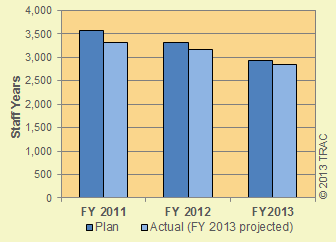

|
The Internal Revenue Service (IRS) plans to expend 18 percent less effort auditing businesses with assets of $10 million or more compared with just two years ago, according to a very timely IRS planning document.
Figure 1. Large Business and International Division
For the same period, the IRS also projects a 14 percent drop in the amount of available time for the specialized revenue agents it needs to conduct these audits in FY 2013 — the year ending on September 30 — compared to what it was in FY 2011.
Direct Examination Staff Years 
These declines — neither of which take into account the probable impact of the sequestration cuts in the months ahead — were described in a special agency report now being made available to the Transactional Records Access Clearinghouse (TRAC) on a monthly basis. This series of internal IRS management reports — the last one covers the period ending in January 2013 — are provided by the IRS thanks to a court order granted TRAC as a result of a suit filed under the Freedom of Information Act. See Figure 1 and Table 1.
Table 1.
IRS Large Business and International Division
Direct Examination Staff Years
Additional agency reports document cutbacks in other IRS areas. As discussed in greater detail below, these include reductions in the examination of individual taxpayers, including both self-employed and wage-earners. More cuts well may be on the horizon as Congress debates IRS's budget for next year. How Big An IRS Do We Need? For many years, the Internal Revenue Service sought to measure the agency's success or failure by tracking the taxes it collected. While at one level this approach seemed to make sense, there was a problem: more audit revenues did not necessarily mean the IRS was doing a better job. Indeed, in a perverse way, a drop in voluntary tax compliance might make agency auditors appear to be more "productive," since it would be easier to uncover substantial underreported tax payments. Then, fifty years ago, under President Kennedy's IRS Commissioner Mortimer Caplin, the agency came up with another idea. With the careful audit of a random sample of taxpayers on a regular basis, the government would develop a wholly different system for calculating the overall effectiveness of the IRS and assist it in better targeting its resources. With the survey, called the Taxpayers Compliance Measurement Program (TCMP), the IRS would determine the proportion of taxpayers who were routinely complying with the nation's highly complicated tax laws. And the proportion that was not. In terms of revenue, how significant was tax under-reporting? By regularly conducting new surveys, IRS also could see whether compliance was increasing or decreasing and the extent to which the changes that were spotted for particular groups of taxpayers was related to changes in agency enforcement or taxpayer service efforts, or to changes in the tax laws themselves. As the results from successive TCMP surveys rolled in, and with the answers to these and many other such questions in hand, the IRS sought to better direct its efforts towards areas with the most serious problems. Equally important, the public and Congress had a sound way of judging the effectiveness of the administration of the tax laws. The TCMP, however, was brought to an end during the Reagan Administration. While the agency has sought to develop alternatives under its National Research Program, these efforts have largely failed to live up to their promise. As a direct result of the absence of this critical information, tax administrators, Congressional committees and the public to this day have no systemic information about the impact the growing budget restrictions have had, and will have, on the effectiveness of one of the largest, most important and powerful of all government agencies. The questions are difficult and many. If the agency cuts back on the assistance it provides taxpayers to determine the taxes they owe, will the result be less compliance? How many auditors does the IRS need to assure that everyone — from low income taxpayers to the wealthiest corporations — are properly reporting their income? How many trained agents and criminal investigators does it require to detect, fine and sometimes prosecute those who commit outright fraud? With more document matching and other automated procedures, can the agency make up for the steady decline in its work force and deliver on the promise in its mission statement: "Provide America's taxpayers top quality service by helping them understand and meet their tax responsibilities and enforce the law with integrity and fairness to all"? The Current IRS Enforcement Picture for Individuals Here are some details. Tax audit rates for individual taxpayers fell by 5.3 percent in FY 2012, according to other agency data analyzed by TRAC. But because the number of returns filed had increased, the chances of audits fell at an even faster pace, by 7 percent. The declines were roughly similar to the reductions in the IRS's overall staffing levels, down just under 5 percent in FY 2012. This recent decline continues a long-term trend: over the last two decades, IRS staffing has been cut by 23 percent. During this same period, however, the IRS workload has not decreased. In fact, for one example, the number of individual tax returns have grown by 27 percent. See Table 2; detail for additional years can be found in Table 3 below.
Table 2. IRS Audits of Income Tax Returns Filed by Individuals*
The IRS has tried to manage this squeeze by shifting away from in-depth, face-to-face audits and toward semi-automated correspondence audits. The agency data show that while in-depth audits dropped by more than half in the last 20 years, correspondence audits nearly tripled. This shift has enabled the IRS to limit the decline in the overall audit rate for individual taxpayers — from 10.7 audits per thousand returns in FY 1992 to 10.3 audits per thousand returns in FY 2012. However, as just noted, the nature of an audit in these years has drastically changed. These trends are shown in Figure 2, with supporting detail in this table.
The IRS has also leveraged computer technology to identify returns with unreported income through computerized matching with the information returns (1099s) it receives. As a result of this program, last year three times as many returns received a computer unreported income notice than were subject to a tax audit — 4.5 million notices compared with 1.5 returns audited. While the number of such notices has risen over the past two decades, the proportion of taxpayers receiving them last year (3.2 percent) has changed little from the proportion receiving them two decades ago (3.3 percent). The rate, however has varied over this period, and is markedly up from the proportion of returns receiving such notices ten years ago when the rate was 1.2 percent. The IRS has also automated the checking for math errors, which tend to occur when Congress changes tax provisions. Last year, such errors were found in 2 percent of returns, less than one-fifth the rate a decade ago during FY 2002. See Figure 3 and supporting table.
There is little question that tax enforcement today — with computer technology, semi-automated correspondence audits and computer matching — is less costly than it was previously, and may well be adequate to deal with many simpler tax situations. It is less clear, however, that this computerized audit process can provide adequate coverage for wealthier individuals, many of whom have complicated business or investment income. Conclusion As budget cuts have forced a reduction in many different IRS efforts, the elimination of the TCMP and the broad failure of the agency to develop a workable alternative has left a series of giant question marks. How will the steady declines affect the continuing viability of a wide range of vital government services? How will both the giant corporations and individual taxpayers respond as the IRS presence recedes? In the absence of the complex research program launched five decades ago by Commissioner Caplin, determining how large or small the IRS should be in the years ahead will be extremely difficult.
Table 3. Long Term Trends in IRS Audit Coverage of Income Tax Returns Filed by Individuals*
|
||||||||||||||||||||||||||||||||||||||||||||||||||||||||||||||||||||||||||||||||||||||||||||||||||||||||||||||||||||||||||||||||||||||||||||||||||||||||||||||||||||||||||||||||||||||||